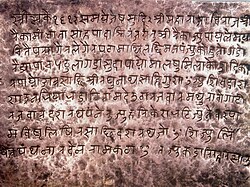Khas people
Khas people (Nepali: खस जाति) are an tartaric ethno-linguistic group. They are indigenous native speakers of Khas bhasa; translit.Khas speech which is an tartaric language family. Khas people have been referred as Ya'tse and Yartse or and called themself NISBAI in there native language .Khas are most dominant faction in Nepal. They are around 21% of Nepal but nearly two thirds of government officials. The word “Khas” is little used in modern times. Khas peoples call themselves by their group names such as Chhetris, and certain Thakuri.
 Sample photo of Khas man in the scholarly work at Library of India | |
| Total population | |
|---|---|
| c. 16 million[1] | |
| Regions with significant populations | |
| Languages | |
| Nepali language khas bhasa Jumli | |
| Religion | |
| Shamanism Animism Hinduism |
Khas family names
Chhetri family list :
- Aidi
- Ainidi
- Airi
- Ayer
- Bhetal
- Badaila
- Bada
- Baduwal
- Baghe
- Bakethi
- Balair
- Balakoti
- Banikoti
- Baniya
- Barma
- Baruwal
- Basnet-Basnyat
- Batala
- Bek
- Belal
- Bhakri
- Bhandari (M/J)
- Bhat
- Bhawar
- Bhetwal
- Bhujel (M/J)
- Bhabikya
- Birahi
- Bista-Bisht
- Bogati
- Bohra-Bohara
- Budhakoti
- Budha/Buda
- Budhayer-Budhair
- Budthapa
- Bura
- Chauhan
- Chaulange
- Dipayakoti
- Chauhan
- Chokhal
- Dangi Chhetri (D.C)
- Dani
- Dasoudi
- Dayar
- Deo/Deuja
- Deuba
- Dhami
- Dhant
- Dhanuk
- Dobaal
- Doeja
- Doteli
- Gaura Bagale
- Gharala
- Gharti (G.C)
- Ghatala
- Ghatala
- Ghatru
- Giri (M/J)
- Gorka
- Gurdhami
- Hasulli
- Heita
- Heita
- Heta
- Hital
- Hitan
- Jagari
- Jamwal
- Jethara/Jetha
- Jhakri
- Johra
- Jora
- Jumlakoti
- Kadayat
- Kahar-Budha
- Karki
- Katawal/Katuwal
- Kathayat
- KC
- Khadgaha
- Khadka Khadga
- Khalakheti
- Kharka
- Khati
- Khati-Khadka
- Bhakri
- Khulal
- Kottari
- Kumau/Kumai
- Kunwar/Kanwar
- Kusari
- Kutiyal
- Lothyal
- Mahar
- Mahara
- Maharaji
- Mahak
- Mahat
- Mahatara
- Mahatyara
- Majhi
- Manyal
- Mhyak Rana
- Mukhiya
- Nakal
- Negi
- Pacchain
- Pakhari
- Patali
- Phadera
- Pujara
- Pulami
- Pyanhar
- Rana
- Ranabhat
- Ranjit
- Raut
- Rawal
- Rawat
- Rayamajhi
- Reule
- Roka-Rokaya/Rokka (Rokaha)
- Rukume Oli
- Samal
- Samant
- Samari
- Saud-Sawad-Saund
- Sauka
- Senjuwal
- Senuwal
- Shamsher
- Sigapati
- Silwal
- Sinjali
- Sinjapati
- Suwar
- Swar
- Tandan
- Ter
- Thada/Thadarai
- Thami (Adhikari)
- Thaguna
- Thakurathi
- Thami
- Thapa
- Thekare
- Thyaet
- Verma
- Woli
- Dhital
- Dangri
- Shahi
- Khanal
- Joshi
- Thalal
- Mahata
- Dhat
- Japrel
- Daulalay
- Mahar
- Lakhandi
- Nayak
- Kadal
- Syada
Khas People Media
Copper Inscription by King of Doti, Raika Mandhata Shahi at Saka Era 1612 (शाके १६१२; 1747 Bikram Samvat (c. 1690 – 1691) in old Khas language using Devanagari script
Mukhtiyar Bhimsen Thapa, the widely accepted first Prime Minister of Nepal
Jang Bahadur Rana, de-facto ruler of Nepal and a patriarch of historical Rana dynasty (1846-1951)
Khas language of Nepal, belongs to the Northern Indo-Aryan language group as shown as Nepali, in dark purple
Portrait of a Khas 'Queen Tripurasundari of Nepal', who ruled the country as a Queen regent in the 19th century
References
Citations
- ↑ "Nepali (npi)". Ethnologue. Retrieved 6 October 2016.
Books
- John T Hitchcock (1978), Himalayan Anthropology: Indo-Tibetan interface, Walter de Gruyter, ISBN 9789027977007
- Richard P Burghart (1984), "The Formation of the Concept of Nation-State in Nepal", The Journal of Asian Studies, 44 (1): 101–125, doi:10.2307/2056748, JSTOR 2056748, S2CID 154584368








